Convert EPSF to G4
Convert EPSF images to G4 format, edit and optimize images online and free.

An EPSF, or Encapsulated PostScript File, is a graphics file format used primarily in the publishing and printing industries for embedding high-resolution images within other PostScript documents. Introduced by Adobe Systems in the late 1980s, EPSF files enable seamless integration of complex visual elements, maintaining quality and device independence. They encapsulate both vector and raster graphics, allowing detailed illustrations and photographs to be embedded without loss of resolution, facilitating professional-quality output across various platforms and devices.
The G4 file extension, standing for CCITT Group 4 Fax Image, is a specialized format used primarily for storing black-and-white facsimile (fax) images. Its origins trace back to the Consultative Committee for International Telegraphy and Telephony (CCITT), now known as the ITU-T, which developed the Group 4 standard in the 1980s to improve fax transmission efficiency over digital networks. This format employs a high compression ratio to reduce file size while maintaining image quality, making it ideal for archiving documents and transmitting faxes in professional and business environments.
Select a EPSF image from your computer, or drag & drop it on the page.
Use any available EPSF to G4 tools on the preview page and click Convert.
Give it a moment for the G4 conversion to complete, then download your file afterward.

To change EPSF format to G4, upload your EPSF file to proceed to the preview page. Use any available tools if you want to edit and manipulate your EPSF file. Click on the convert button and wait for the convert to complete. Download the converted G4 file afterward.
Follow steps below if you have installed Vertopal CLI on your macOS system.
cd to EPSF file location or include path to your input file.Follow steps below if you have installed Vertopal CLI on your Windows system.
cd to EPSF file location or include path to your input file.Follow steps below if you have installed Vertopal CLI on your Linux system.
cd to EPSF file location or include path to your input file.